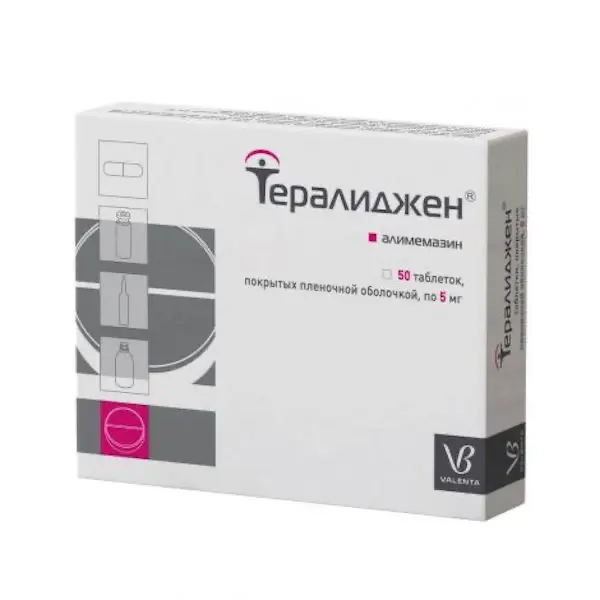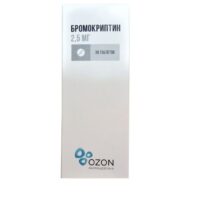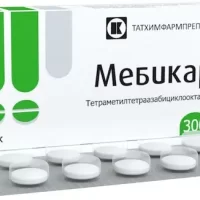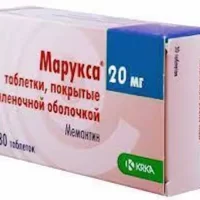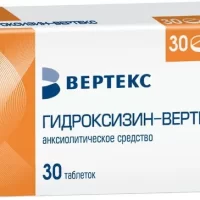Description
Teralizen Pharmacodynamics
It is a derivative of phenothiazine. Alimemazine acts as a mild sedative and anti-anxiety drug, has a positive effect on senestopathy, obsessions and phobias. It is used for psychosomatic manifestations developing due to neurovegetative disorders, vascular, traumatic and infectious disorders of the central nervous system. Sedative effect promotes normalization of sleep in patients of this category. It has antiemetic and anti-cough activity. Sedative and anxiolytic effect is caused by blockade of adrenoreceptors of reticular formation of the brain stem. Antiemetic and vegetative stabilizing effect is caused by blockade of dopamine D2-receptors of the trigger zone of the vomiting center. Due to its antihistamine activity, alime-mazine is used for allergic diseases, especially of the respiratory tract, and for itching of the skin. Alimeazine is more active in antihistamine and sedative action than diprazine. The antipruritic action is due to its effect on type 1 histamine receptors.
Indications
In adults and children from 7 years old:
As a sedative (sedative), anxiolytic (anti-anxiety) and as a sleep aid:
– Dementia (including dementia due to epilepsy) proceeding with manifestations of psychomotor agitation, anxiety affect (as part of combined therapy);
– Organic anxiety disorder (as monotherapy or as part of combined therapy);
– schizophrenia (with prevalence of neurosis-like disorders, as part of combined therapy);
– mood disorders (affective disorders) – as part of combined therapy;
– generalized anxiety disorder (as part of combined therapy);
– Obsessive-compulsive disorder (as part of combined therapy);
– reaction to severe stress and adaptive disorders (acute reaction to stress, post-traumatic stress disorder, unspecified reaction to severe stress, other reactions to severe stress) – as part of combined therapy;
– dissociative (conversion) disorders (as part of combined therapy);
– somatoform disorders (somatization disorder, undifferentiated somatoform disorder, hypochondriacal disorder, somatoform dysfunction of autonomic nervous system, stable somatoform pain disorder, unspecified somatoform disorder, other somatoform disorders) – as part of combined therapy for severe anxiety or if standard therapy is not effective;
– unspecified autonomic nervous system disorder, other autonomic nervous system disorders (as part of combined therapy);
– Anorexia nervosa (as part of the combined therapy);
– Emotionally unstable personality disorder (impulsive and borderline types) – as part of combined therapy;
– Hysterical personality disorder, anxious (evasive, avoidant) personality disorder (as part of combined therapy);
– Persistent change in personality after experiencing a disaster (as part of combined therapy);
– hyperkinetic behavior disorder (as part of combined therapy);
– Family-restricted behavioral disorder (as part of combination therapy when standard therapy is ineffective);
– Non-socialized conduct disorder (as part of monotherapy or as part of combination therapy);
– anxiety, agitation and other symptoms and signs related to emotional states (as part of combination therapy);
– other neurotic disorders (neurasthenia, unspecified neurotic disorder) – as part of combined therapy;
– insomnia of non-organic etiology (as part of combined therapy if standard therapy is ineffective);
– emotional disorders, the onset of which is specific to childhood (phobic anxiety disorder in childhood, social anxiety disorder in childhood, disorder due to sibling rivalry (with siblings), unspecified emotional disorder in childhood, other emotional disorders in childhood) – as part of combination therapy.
As an anti-allergic agent:
– Pruritus irrespective of location and etiology (anal itching, vulvar itching, unspecified anogenital itching, itching in photocontact dermatitis and solar urticaria, dermatitis, eczema, urticaria, bites or stings from non-venomous insects or other non-venomous arthropods, varicella, measles, Hodgkin’s disease, diabetes, shingles) as monotherapy or as part of combination therapy;
– asthma, pollinosis, whooping cough (as part of complex therapy as an anti-allergic agent to relieve cough, shortness of breath and suffocation);
– Unspecified allergies (as monotherapy or as part of combined therapy).
Contraindications
– Hypersensitivity to the components of the drug;
– lactose intolerance, lactase deficiency, glucose-galactose malabsorption;
– closed-angle glaucoma;
– prostatic hyperplasia;
– severe hepatic and/or renal insufficiency;
– parkinsonism;
– myasthenia gravis;
– Reye’s syndrome;
– concomitant use of monoamine oxidase inhibitors (MAO);
– pregnancy;
– lactation;
– Children under 3 years of age when used as an anti-allergic agent and for sedation before surgical intervention; under 7 years of age for other indications.
Precautions for use.
The drug should be used with caution in case of alcoholism, if there is a history of complications with the use of drugs of phenothiazine series;
bladder neck obstruction; predisposition to urinary retention; epilepsy; open-angle glaucoma; jaundice; bone marrow dysfunction; arterial hypotension.
Administration during pregnancy and lactation
It is contraindicated in pregnancy and during lactation (breast-feeding). If pregnancy occurs during the treatment period, the drug should be discontinued. If it is necessary to apply the drug during lactation, stop breast-feeding.
Dosage and administration
- Inside. Without chewing. The action of the drug is dose-dependent and the doses are chosen depending on the therapy goals.
- Adults .
- To achieve the vegetal stabilizing effect, 15-60 mg/day.
- To achieve an anxiolytic effect 20-80 mg/day.
- To achieve a sedative and/or hypnotic effect 5-10 mg once (20-30 min before sleep).
- For symptomatic treatment of allergic reactions 10-40 mg/day.
- Course treatment should be started with 2.5-5 mg in the evening with gradual increase of daily dose to desired effect. A daily dose can be divided into 3-4 doses.
- Duration of treatment course may be 2 to 6 months or more and is determined by the physician.
- The highest dose for adults is 500 mg/day, for elderly people (over 60 years) -200 mg/day.
- Children from 7 years old are prescribed according to the following scheme (depending on age and body weight).
- To achieve an anxiolytic effect, 20-40 mg/day.
- The course of treatment should be started with 2.5-5 mg with gradual increase in the daily dose to the desired effect. The daily dose may be divided into 3-4 doses.
- To achieve a sedative and/or hypnotic effect, 2.5-5 mg once (20-30 minutes before sleep).
- To achieve a sedative effect in behavioral disorders in psychotic states, it is possible to increase the daily dose to 60 mg/day.
- For symptomatic treatment of allergic reactions 5-20 mg/day.
- Course of treatment may last from 2 to 6 months or more and is determined by the physician.
- For children from 3 years old.
- For symptomatic treatment of allergic reactions 2.5-5 mg 3-4 times a day.
- Duration of the course of treatment may be from 2 to 6 months or more and is determined by the physician.
- For sedation before surgery, children from 3 to 7 years of age are prescribed at a rate of 2 mg/kg 1-2 hours before surgery. The maximum daily dose is 2 mg/kg.

